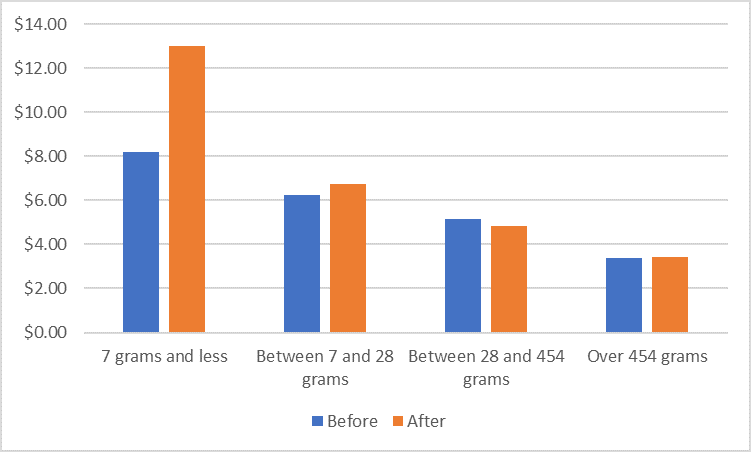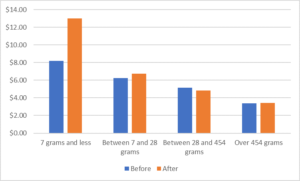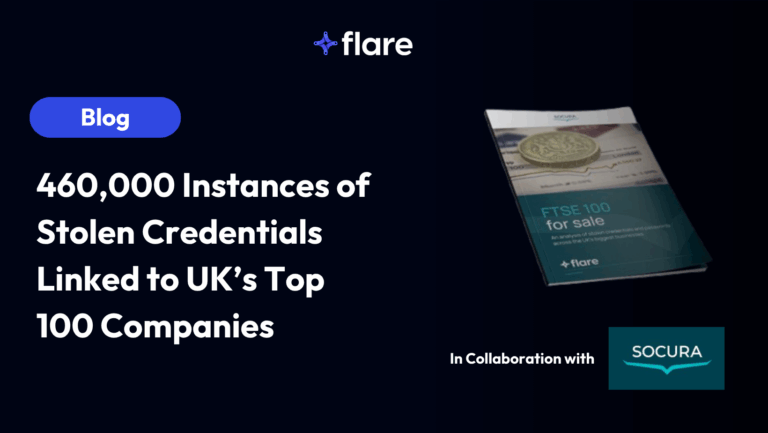
Canada went through a historic transformation on October 17th. On that date, Canada became the first Western industrialized country to legalize recreational cannabis (RC). Given that an estimated 2 million Canadians use recreational cannabis, the legalization of RC removes much stress of legal sanctions. It will also likely lead to a shift in how police and judicial resources are allocated. The prohibition of cannabis is not the first prohibition that Canada has removed. From 1918 to 1920, Canada briefly banned alcohol in line with a movement in the United States. The legalization of cannabis provides though for an interesting analysis of how the black market reacts to the end of prohibition.
Black markets operate under different conditions than that of licit markets because of the risks of arrests of their participants. General supply and demand and economies of scale however apply both to black and licit markets. Figure 1 compares the price of cannabis before and after the legalization of cannabis by Canadian vendors on cryptomarkets. Cryptomarkets are darknet black markets where much of the illicit drugs is now sold online.
Figure 1: Price per gram of cannabis sold by Canadian dealers on cryptomarkets

The Figure shows that the price per gram goes down as buyers make large purchases. It also shows that the price per gram for purchases of over a pound is about a third of the price paid when buying small (under 7 grams) quantities of cannabis. The prices before the legalization compare advantageously to those paid by US buyers. These buyers pay on average $8.99 for purchases of between 10 and 28 grams (-15%), $5.73 for purchases between 28 and 454 grams (-16%) and $4.72 for purchases of over a pound (-27%). Given the proximity of Canada and the United States, these differences are interesting and we were curious to understand how legalization impacted them.
Our analyses show that prices of cannabis appear to have increased AFTER the legalization of cannabis in Canada for some price categories. The difference is marginal at the higher echelons (up to 7%) but are much more significant for small purchases of 7 grams and less. A more detailed explanation of this change would need to be validated through interviews with cannabis dealers.
Differences in prices
The law of risks and prices however suggests that drug dealers are aware of the risks they incur through their activities. Drug dealers price their products accordingly. If they increased their price such significantly, it may be because the law enforcement agencies are now monitoring much closely the activities of the dealers. These dealers indeed compete with the legal stores of recreational cannabis.
News media report many police actions in Canada targeting cannabis dealers on the internet. This higher attention of law enforcement could make it less profitable for dealers to sell cannabis in small quantities, driving up the price. The minimal penalties for trafficking are indeed at least of 1 year in prison for cannabis traffickers. This is a very stiff sentence compared to the lenient attitude of law enforcement in the months and years that led to cannabis legalization in Canada.
This analysis is admittedly based on a very small sample of cannabis ads by Canadian vendors given the still very recent legalization of cannabis. We will update these tables in the coming months as we have a larger sample of ads to draw from and the impact of legalization is better known.
Subscribe to our blog to stay up to date on darknet and cybersecurity.





